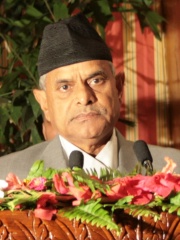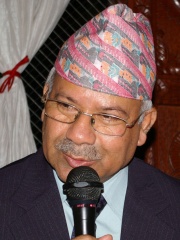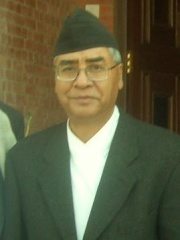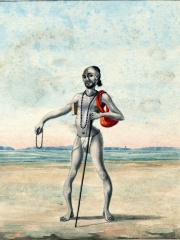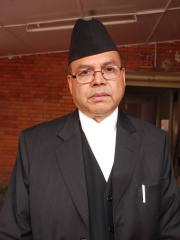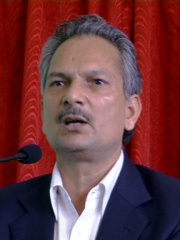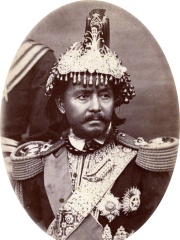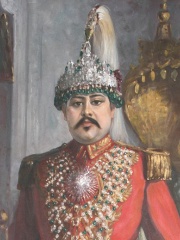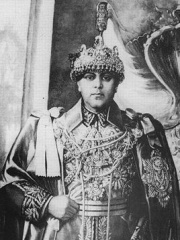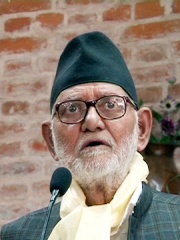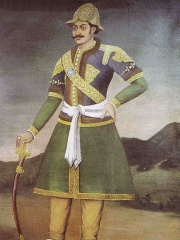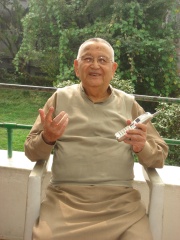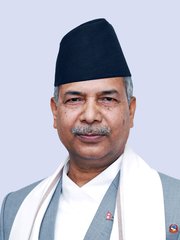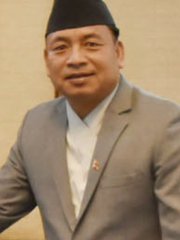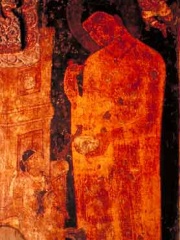
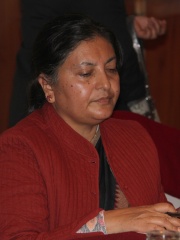
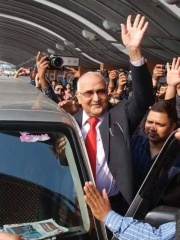
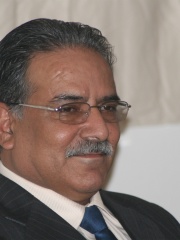
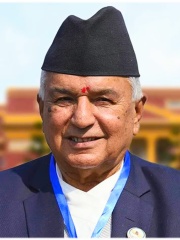
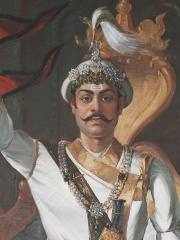
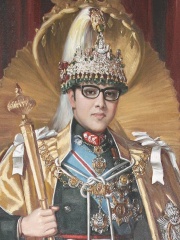
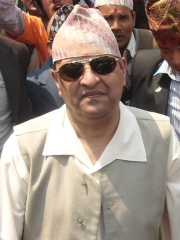
The Most Famous
POLITICIANS from Nepal
This page contains a list of the greatest Nepalese Politicians. The pantheon dataset contains 19,576 Politicians, 35 of which were born in Nepal. This makes Nepal the birth place of the 81st most number of Politicians behind Indonesia, and Cyprus.
Top 10
The following people are considered by Pantheon to be the top 10 most legendary Nepalese Politicians of all time. This list of famous Nepalese Politicians is sorted by HPI (Historical Popularity Index), a metric that aggregates information on a biography's online popularity. Visit the rankings page to view the entire list of Nepalese Politicians.

1. Yaśodharā (b. 600 BC)
With an HPI of 77.75, Yaśodharā is the most famous Nepalese Politician. Her biography has been translated into 35 different languages on wikipedia.
Yaśodharā or Yashodhara, originally known as Bhaddakaccānā (Pāli) or Bhadrakātyāyani (Sanskrit), was an Indian princess and the wife of Prince Siddhartha prior to his renunciation to become a śramaṇa (ascetic). She was the mother of Rāhula, and the niece of Mahaprajapati Gautami. Later, she became a Bhikkhunī and is considered an arahatā.

2. Bidhya Devi Bhandari (b. 1961)
With an HPI of 73.07, Bidhya Devi Bhandari is the 2nd most famous Nepalese Politician. Her biography has been translated into 79 different languages.
Bidya Devi Bhandari (Nepali: विद्यादेवी भण्डारी, pronounced [bid̚djadebi bʱʌɳɖaɾi]; born 19 June 1961) is a Nepali former politician who served as the second president of Nepal from 2015 to 2023. She formerly served as the minister of defence and minister of environment and population. She is the first woman to hold the presidential office in the country. She served as the vice-chairperson of the Communist Party of Nepal (Unified Marxist–Leninist) and was the chair of the All Nepal Women's Association before being elected president. Bhandari previously served as the Minister of Defence, the first woman to hold the office, from 2009 to 2011. She also served as the Minister of Environment and Population in 1997, and has been an active campaigner for environmental awareness and women's rights in Nepal. In June 2017, she visited the headquarters of the International Union for Conservation of Nature in Gland, Switzerland and met with the director general Inger Andersen to discuss enhanced collaboration on nature conservation and sustainable development. In 2016, Forbes placed her at number 52 on its list of the world's 100 most powerful women.

3. KP Sharma Oli (b. 1952)
With an HPI of 72.65, KP Sharma Oli is the 3rd most famous Nepalese Politician. His biography has been translated into 46 different languages.
Khadga Prasad Sharma Oli (born 22 February 1952) is a Nepalese politician who thrice served as the 38th prime minister of Nepal from 2015 to 2016, 2018 to 2021, and 2024 to 2025. He has served as the chairman of the Communist Party of Nepal (Unified Marxist–Leninist) since 2014. Oli has been Member of Parliament for Jhapa 5 since 2017. He previously served as an MP for Jhapa 6, Jhapa 2, and Jhapa 7. Oli opposed the 2015 blockade of Nepal by India. He strengthened relations with China as an alternative to Nepal's traditionally close trade ties with India. Oli's tenure in office has been controversial for frequent use of tongue-in-cheek remarks, hostility towards critics and the media, and accusations of fostering cronyism and corruption. On 9 September 2025, he resigned as prime minister in the wake of the Gen Z protests.

4. Pushpa Kamal Dahal (b. 1954)
With an HPI of 72.40, Pushpa Kamal Dahal is the 4th most famous Nepalese Politician. His biography has been translated into 49 different languages.
Pushpa Kamal Dahal (born Ghanashyam Dahal; 11 December 1954), also known as Prachanda, is a Nepalese politician. He has been prime minister of Nepal three times: from 2008 to 2009, from 2016 to 2017, and again from December 2022 until July 2024. His third term ended on 12 July 2024 after he lost a vote of confidence in parliament. He was then replaced by Khadga Prasad Sharma Oli. After leaving office, Dahal became the Leader of the Opposition on 15 July 2024, remaining in that position until September 2025. Having been drawn to left-wing politics after seeing severe poverty during his youth, Dahal joined the Communist Party of Nepal (Fourth Convention) in 1981, and later became general secretary of the Communist Party of Nepal (Mashal) in 1989. This party later became the Communist Party of Nepal (Maoist). Dahal was the leader of the CPN (M) during the country's civil war and subsequent peace process and the 1st Nepalese constituent assembly. In the 2008 elections, CPN(M) emerged as the largest party, and Dahal became prime minister in August of that year. He resigned from the post on 4 May 2009, after his attempt to sack the then army chief, Rookmangud Katawal, was opposed by then President Ram Baran Yadav. Dahal was sworn in as prime minister for a second time in 2016, as per an agreement to form a rotational government with the Nepali Congress, and resigned on 24 May 2017 to make way for Congress' Sher Bahadur Deuba. Following the 2022 general election, Dahal was sworn in as prime minister again in December 2022, with support from a coalition of parties including CPN (UML), Rastriya Swatantra Party and Rastriya Prajatantra Party. Dahal remained in power for 19 months, changing alliances between the UML and Congress three times, before he was ousted by a failed motion of confidence in the parliament on 12 July 2024.
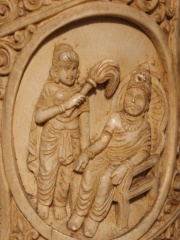
5. Śuddhodana (b. 590 BC)
With an HPI of 71.73, Śuddhodana is the 5th most famous Nepalese Politician. His biography has been translated into 37 different languages.
Śuddhodana (Sanskrit: शुद्धोदन; Pali: Suddhodana), meaning "he who grows pure rice," was the father of Siddhartha Gautama, better known as the Buddha. He was a leader of the Shakya, who lived in an oligarchic republic, with their capital at Kapilavastu. In later renditions of the life of the Buddha, Śuddhodana was often referred to as a king, though that status cannot be established with confidence and is in fact disputed by modern scholars.

6. Ram Chandra Poudel (b. 1944)
With an HPI of 66.56, Ram Chandra Poudel is the 6th most famous Nepalese Politician. His biography has been translated into 39 different languages.
Ram Chandra Paudel (born 6 October 1944) is a Nepalese politician who is serving as the third president of Nepal since 2023. A former senior leader of the Nepali Congress, Paudel previously served as the speaker of the House of Representatives from 1994 to 1999, and was the deputy prime minister and Minister for Home Affairs from 1999 to 2002. First elected to parliament in 1991, he served in numerous other ministerial positions and was the Leader of the Opposition from 2011 to 2013, as the parliamentary party leader of the Nepali Congress.

7. Prithvi Narayan Shah (1723 - 1775)
With an HPI of 66.24, Prithvi Narayan Shah is the 7th most famous Nepalese Politician. His biography has been translated into 36 different languages.
Prithvi Narayan Shah (Nepali: श्री ५ बडामहाराजाधिराज पृथ्वीनारायण शाह देव, romanized: Shri Panch Badamaharajadhiraj Prithvi Narayan Shah Dev; 11 January 1723 – 11 January 1775) was the last king of the Gorkha Kingdom and the first monarch of the unified Kingdom of Nepal, also referred to as the Kingdom of Gorkha. He is credited with initiating the unification of Nepal and relocating the royal seat of power to Kathmandu. His reign marked the end of the medieval period and the beginning of the modern history of Nepal. Prithvi Narayan Shah played a central role in the formation of modern Nepal through his campaigns of territorial consolidation. He is considered a prominent figure in Nepalese history, and his efforts at political unification and national identity continue to be recognized in contemporary narratives. Scholars have drawn comparisons between his historical role and that of George Washington in the United States, citing his vision and leadership within the context of 18th-century South Asia. Some interpretations highlight his efforts to mobilize public support and establish a foundation for a unified state. His legacy remains influential in Nepal's political and cultural discourse.

8. Birendra of Nepal (1945 - 2001)
With an HPI of 66.17, Birendra of Nepal is the 8th most famous Nepalese Politician. His biography has been translated into 47 different languages.
Birendra Bir Bikram Shah Dev (Nepali: श्री ५ महाराजाधिराज वीरेन्द्र वीर विक्रम शाह देव; 29 December 1945 – 1 June 2001) was King of Nepal from 1972 until his assassination in 2001. Birendra was the second son of King Mahendra and became crown prince on account of Mahendra's first son being born out of wedlock. He inherited the panchayat system from his father when he acceded the throne in 1972, ruling as Nepal's absolute monarch. Following the 1990 revolution, he disbanded the system, lifted the concurrent ban on political parties and promulgated a new constitution in which he served as head of state of a democratic constitutional monarchy. The Nepalese Civil War began in the latter part of his reign when the Communist Party of Nepal launched an insurgency in 1996.

9. Gyanendra of Nepal (b. 1947)
With an HPI of 65.97, Gyanendra of Nepal is the 9th most famous Nepalese Politician. His biography has been translated into 51 different languages.
Gyanendra Bir Bikram Shah Dev (Nepali: ज्ञानेन्द्र बीर बिक्रम शाह देव; born 7 July 1947) was the last king of Nepal. He reigned from 1950 to 1951 and again from 2001 to 2008, when the Kingdom of Nepal was abolished and a republic declared. At a young age of three, Gyanendra was briefly declared king by the Rana regime after his grandfather Tribhuvan and his family fled to India. During his brother Birendra's reign, he served as chairman of the King Mahendra Trust for Nature Conservation. Gyanendra's second reign, which began as a result of the Nepalese royal massacre, was characterised by constitutional upheaval. The growing insurgency of the Nepalese Civil War disrupted representative elections. Following several election delays, Gyanendra suspended the constitution and assumed direct rule in February 2005, claiming that it was a temporary measure to suppress the Maoist insurgency after civilian governments failed to do so. In April 2006, despite widespread opposition, he restored Nepal's previous parliament. Following the signing of the Comprehensive Peace Accord between the government and the Maoists, he was deposed two years later by the first session of the Constituent Assembly, which declared a republic and ended the 240-year rule of the Shah dynasty.
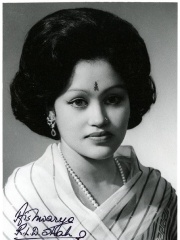
10. Queen Aishwarya of Nepal (1949 - 2001)
With an HPI of 65.63, Queen Aishwarya of Nepal is the 10th most famous Nepalese Politician. Her biography has been translated into 22 different languages.
Aishwarya Rajya Laxmi Devi Shah (Nepali: ऐश्वर्य राज्य लक्ष्मी देवी शाह) (7 November 1949 – 1 June 2001) was Queen of Nepal from 1972 until her assassination in 2001. She played a significant role as the consort of King Birendra and was a prominent figure in the royal family throughout her lifetime. Queen Aishwarya is regarded by many Nepalese as an influential figure, known for her steadfast presence. During the pre-1990 era of absolute monarchy, she was often considered to be a central influence behind the throne. While her sense of style shaped the cultural ideal for many, her influence went beyond appearance. She was seen as a figure of composure and support alongside her husband during a period of both political change and royal tradition. In addition to her public role, Queen Aishwarya was a patron of the arts and made contributions to the cultural landscape of Nepal. She was known for her literary works and involvement in music, composing and writing songs under the pen-name "Chandani Shah".
People
Pantheon has 35 people classified as Nepalese politicians born between 600 BC and 1980. Of these 35, 15 (42.86%) of them are still alive today. The most famous living Nepalese politicians include Bidhya Devi Bhandari, KP Sharma Oli, and Pushpa Kamal Dahal. The most famous deceased Nepalese politicians include Yaśodharā, Śuddhodana, and Prithvi Narayan Shah. As of April 2024, 3 new Nepalese politicians have been added to Pantheon including Ram Sahaya Yadav, Nanda Kishor Pun, and Chanira Bajracharya.
Living Nepalese Politicians
Go to all RankingsBidhya Devi Bhandari
1961 - Present
HPI: 73.07
KP Sharma Oli
1952 - Present
HPI: 72.65
Pushpa Kamal Dahal
1954 - Present
HPI: 72.40
Ram Chandra Poudel
1944 - Present
HPI: 66.56
Gyanendra of Nepal
1947 - Present
HPI: 65.97
Ram Baran Yadav
1948 - Present
HPI: 64.64
Madhav Kumar Nepal
1953 - Present
HPI: 63.88
Jigme Khesar Namgyel Wangchuck
1980 - Present
HPI: 62.77
Sher Bahadur Deuba
1946 - Present
HPI: 58.32
Ashtavakra
HPI: 55.67
Jhala Nath Khanal
1950 - Present
HPI: 54.52
Baburam Bhattarai
1954 - Present
HPI: 51.25
Deceased Nepalese Politicians
Go to all RankingsYaśodharā
600 BC - Present
HPI: 77.75
Śuddhodana
590 BC - Present
HPI: 71.73
Prithvi Narayan Shah
1723 - 1775
HPI: 66.24
Birendra of Nepal
1945 - 2001
HPI: 66.17
Queen Aishwarya of Nepal
1949 - 2001
HPI: 65.63
Jung Bahadur Rana
1817 - 1877
HPI: 64.89
Prithvi Bir Bikram Shah
1875 - 1911
HPI: 64.20
Tribhuvan of Nepal
1906 - 1955
HPI: 60.76
Mahendra of Nepal
1920 - 1972
HPI: 60.38
Sushil Koirala
1939 - 2016
HPI: 58.03
Bhimsen Thapa
1775 - 1839
HPI: 57.55
Surya Bahadur Thapa
1928 - 2015
HPI: 54.66
Newly Added Nepalese Politicians (2025)
Go to all RankingsRam Sahaya Yadav
1971 - Present
HPI: 44.89
Nanda Kishor Pun
1966 - Present
HPI: 43.00
Chanira Bajracharya
HPI: 24.95
Overlapping Lives
Which Politicians were alive at the same time? This visualization shows the lifespans of the 16 most globally memorable Politicians since 1700.

